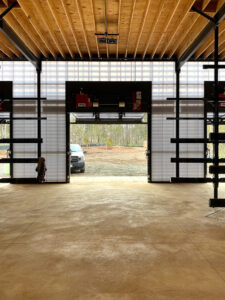Bifold Doors and Metal Storage
Boost Boathouse Efficiency
by hanna_kowal | October 20, 2025 8:25 pm
 [1]
[1]A large-scale bifold door and metal storage systems installation at the Beaverdam Reservoir Park in Ashburn, Va., creates an accessible and eye-catching experience for school rowing teams and users of the new boathouse.
 [2]
[2]A common sight in a visit to the Beaverdam Reservoir Park in Ashburn, Va., during the early evening or on a springtime Saturday morning, will be a few rowing boats, or shells, on the water, crewed by several scholastic rowing teams. The 121.4 ha (300 acre) reservoir has been a popular place for crew teams to practice.
A part of the project that created the park, the dedicated boathouse provides shell storage and facilities for the athletes with a sleek and simple black metal storage system. Designed by Studio Twenty Seven Architecture of Washington, D.C., the building is reminiscent of a lantern. Integrated into the building’s design are eight liftstrap bifold doors, measuring 3.7 m (12 ft), 0.063 x 2.7 m (0.2 x 9 ft), 76.2 mm (3 in.). Providing access in and out of the building, there are four doors on each side of the structure. The doors were engineered to hold the polycarbonate and wood cladding and include metal in side-latch switches, electric photo eye sensors, and emergency back-up hand cranks.
“During the day, you go inside and you kind of get the sense of the light filtering through the building,” says Bethan Llewellyn-Yen, lead architect at Studio Twenty Seven Architecture. “At nighttime, when you’re outside and the doors are closed, it all kind of glows.”
 [3]
[3]Llewellyn-Yen says they wanted a door that could be customized to work with the vision of the building and have minimal impact on the interior of the boathouse. Inside there are metal shelves to store over 60 rowing shells, requiring open space to be able to maneuver the shells in and out.
The Beaverdam Reservoir is a man-made body of water, created by damming a portion of the Beaverdam Creek to provide drinking water for the surrounding communities. The reservoir and surrounding land became a popular place to fish, row, hike and just escape to nature in the highly built-up area surrounding Washington D.C.
The project at the reservoir created a new park with upgraded amenities while also working to protect the natural environment and water quality of the reservoir. The project was a partnership between Loudoun Water, which owns the reservoir, and the Northern Virginia Regional Park Authority (NOVA Parks), which operates parks and recreational facilities across northern Virginia. Nelson Byrd Woltz Landscape Architects was chosen as the designer of the overall park. That firm hired Studio Twenty Seven to help with the design of the structures.
“We took to heart this idea of promoting civic infrastructure and water source protection,” Llewellyn-Yen says. “Water was the prime client and we wanted our buildings to showcase the importance of protecting the water source. Every building in the design looks to capture every rain drop and from there directly to the reservoir.”
 [4]
[4]The welcome center and picnic pavilions all have V-shaped roofs that collect rainwater, direct it off the roof and into a rain basin on the ground. The basins are designed to hold the water temporarily before allowing it to slow drain toward the reservoir. The landscape was created to function as a living water filter, grabbing sediments and pollutants from the water. This helps keep the water in the reservoir clean.
- [Image]: https://www.metalarchitecture.com/wp-content/uploads/2025/10/Beaverdam3.jpg
- [Image]: https://www.metalarchitecture.com/wp-content/uploads/2025/10/Beaverdam4.jpg
- [Image]: https://www.metalarchitecture.com/wp-content/uploads/2025/10/Beaverdam2.jpg
- [Image]: https://www.metalarchitecture.com/wp-content/uploads/2025/10/Beaverdam1.jpg
Source URL: https://www.metalarchitecture.com/news/industry-news/bifold-doors-and-metal-storage/